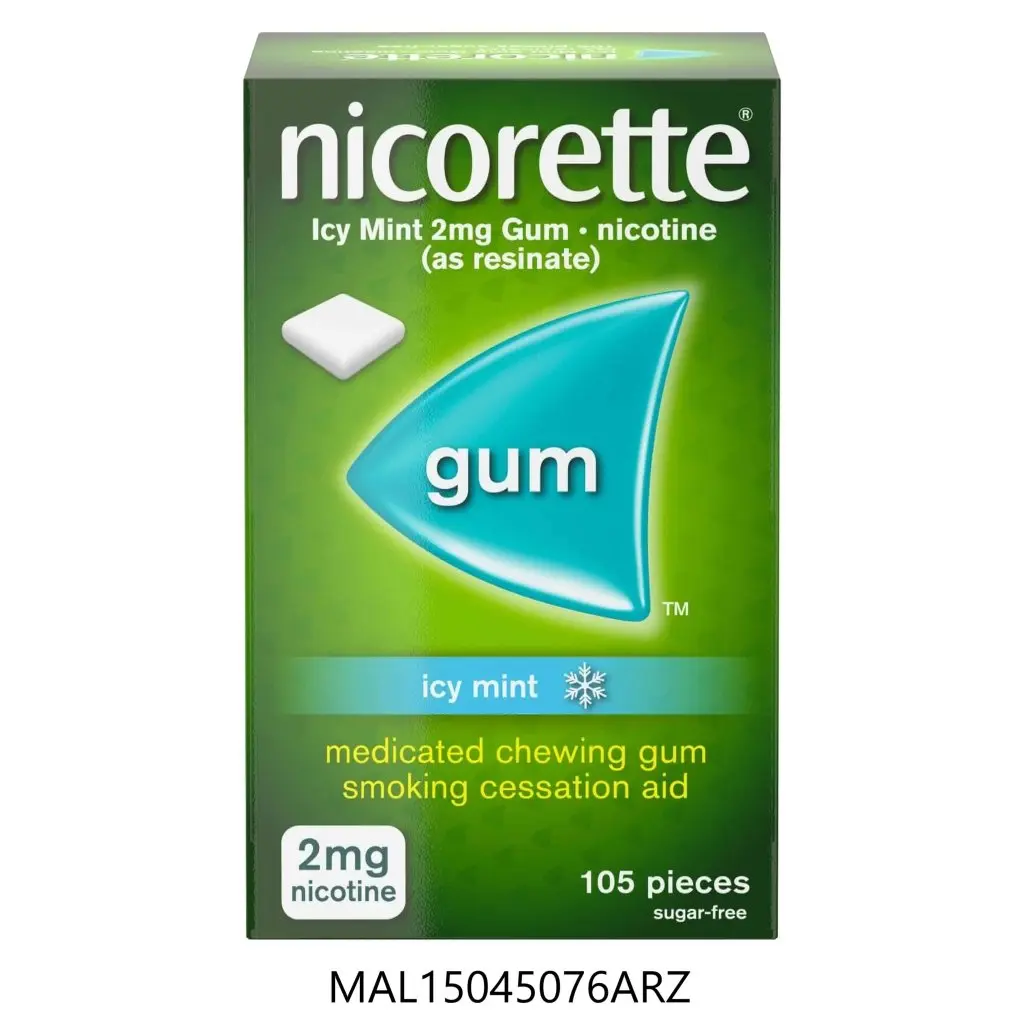Nicorette® Icy Mint Gum
NAME OF THE PRODUCT
Nicorette® icy mint 2mg gum
Nicorette® icy mint 4mg gum
ACTIVE INGREDIENT
Nicotine 2mg and 4mg
INACTIVE INGREDIENTS
- Nicorette® icy mint 2mg gum • nicotine (as resinate): Chewing gum base, levomenthol, acesulfame potassium, talc, magnesium oxide (light), xylitol, peppermint oil, sodium carbonate anhydrous, and sodium hydrogen carbonate.
- Nicorette® icy mint 4mg gum • nicotine (as resinate): Chewing gum base, xylitol, levomenthol, quinolone yellow E104 Al-lake, acesulfame potassium, magnesium oxide (light), peppermint oil, sodium carbonate anhydrous, and talc.
PHARMACEUTICAL FORM
Nicorette® icy mint 2mg gum • nicotine (as resinate):
A white coloured coated square chewing gum with a size of about 15 x 15 x 6 mm
Nicorette® icy mint 4mg gum • nicotine (as resinate):
A crème coloured coated square chewing gum with a size of about 15 x 15 x 6 mm
PHARMACOLOGY
Pharmacodynamics
Pharmacotherapeutic group: Drug used in nicotine dependence. ATC code: N07B A01
A sudden stop of smoking for long term smokers will experience the following withdrawal symptoms:
urge or craving to smoke, dysphoria or depressed mood, insomnia, irritability, frustration or aggression, anxiety, difficulty in concentrating, restlessness or impatience, reduced heart rate, increased appetite or increase in weight.
Clinical studies have shown that nicotine replacement products can help smokers quit or reduce their smoking by helping these withdrawal symptoms.
Pharmacokinetics
Nicotine administered from a piece of nicotine chewing gum depends on the quantity of nicotine released into the oral cavity and readily absorbed through the oral mucosa. Maximum blood concentration is achieved after 30 minutes of chewing and is proportionate to the concentration 20- 30 minutes after smoking a cigarette. The major eliminating organ is the liver. Greatly impaired kidney function is assumed to affect total clearance of nicotine.
INDICATION
Nicorette® is used for the treatment of tobacco dependence by relieving nicotine craving and withdrawal symptoms. Facilitating smoking cessation in smokers motivated to quit.
As an aid to reduce smoking [Nicotine Assisted Reduction to Stop (NARS)].
DOSAGE AND ROUTE OF ADMINISTRATION
Stop smoking completely at the same time in order to increase your chances of success. Regular use beyond 12 months is generally not recommended.
Adults:
The initial dosage should be individualized on the basis of the smoker’s nicotine dependence. The Nicorette® chewing gum 4mg is recommended for smokers who are highly dependent (for example smoking 20 cigarettes or more per day or smoking the first cigarette in the morning 30 minutes or less after waking up). Other smokers should begin treatment with the 2mg dosage strength.
The Nicorette® chewing gum should be used when cigarettes normally would have been smoked or if cravings emerge. Sufficient Nicorette® chewing gum should be used each day. In order to maximize the chances of success it is important not to underdose. The dosage should be individualized on the basis of the smoker’s nicotine dependence.
Dosing regimen:
8 to 12 Nicorette® chewing gum per day, for at least 3 months. Do not exceed the following number of
gums as stated below in any 24-hour period.
Dosage Form | Maximum Quantity per day |
2mg | 30 pieces |
4mg | 24 pieces |
Smokers should stop smoking completely during the course of treatment with Nicorette® chewing gum.
Gradual tapering from the Nicorette® chewing gum should then be initiated. Treatment should be stopped when the dose is reduced to 1 to 2 Nicorette® chewing gum per day.
Each piece of Nicorette® chewing gum should be chewed slowly for approximately 30mins, with pauses.
The gum should be chewed until a strong taste or mild burning sensation is experienced, then rested between the cheek and gums until the taste and/ or sensation have disappeared, then chew again slowly and repeat.
Children and adolescents: Do not administer Nicorette® chewing gum to persons under 18 years of age without recommendation from a health care professional.
Combination therapy:
Highly dependent smokers, smokers who experience “breakthrough” cravings or those who have failed with single NRT treatment, can use a flexible smoking cessation format, in combination with the patch for fast relief of cravings. Use same dosing recommendation for both patch and gum as per mono therapy. Upon control of cravings, start with tapering patch and gum as directed in mono therapy.
Administration of nicotine should be stopped temporarily if any symptoms of nicotine excess occur.
Nicotine intake should be decreased by either lowering dosing frequency or strength if nicotine excess symptoms persist.
CONTRAINDICATION
Hypersensitivity to nicotine or any excipients in the chewing gum.
WARNING AND PRECAUTIONS
Smokers who wear dentures may experience difficulty in chewing Nicorette® chewing gum. The chewing gum may stick to and may in rare cases damage dentures.
Before taking the Nicorette® chewing gum, please consult with your healthcare professional if you have the following conditions:
Serious cardiovascular event (heart disease), or recently hospitalized for a cardiovascular complaint e.g., stroke, myocardial infarction, unstable angina, cardiac arrhythmia, coronary artery bypass graft and angioplasty or suffer from uncontrolled hypertension (high blood pressure)
Diabetes
Severe or moderate liver disease
Severe kidney disease
An overactive thyroid gland
A tumor of the adrenal gland (phaeochromocytoma)
Stomach ulcer
Oesophagitis
Ever experienced of epilepsy and seizures
If symptoms persist or get worse, or if new symptoms occur, stop use and consult your healthcare professional.
INTERACTION WITH OTHER MEDICAMENTS
Tell your healthcare professional if you are taking or have recently taken any other medicines, including medicines obtained without a prescription. This is especially important if you take medicine containing:
theophylline, tacrine, clozapine, ropinirole, imipramine, olanzapine, clomipramine, fluvoxamine, flecainide and pentazocine.
PREGNANCY AND LACTATION
Pregnancy
Nicotine passes to the foetus and affects its breathing movements and circulation. The effect on the circulation is dose dependent. Therefore, the pregnant smoker should always be advised to stop smoking completely without use of nicotine replacement therapy. The risk of continued smoking may pose greater hazard to the foetus as compared with the use of nicotine replacement products in a supervised smoking cessation programme. Use of Nicorette® chewing gum by the pregnant smoker should only be initiated after advice from a health care professional.
Lactation
Women should take the product just after having breastfeeding. Nicotine passes freely into breast milk in quantities that may affect the child even with therapeutic doses. Nicorette® chewing gum should therefore be avoided during breast-feeding. Should smoking cessation not be achieved, use of the Nicorette® chewing gum by breast feeding smokers should only be initiated after advice from a health care professional.
SIDE EFFECTS
Most of the undesirable effects reported by the subjects occur during the early phase of treatment and are mainly dose dependent. Irritation in the mouth and throat may be experienced, however most subjects adapt to this with ongoing use. Allergic reactions (including symptoms of anaphylaxis) occur rarely during use of Nicorette® chewing gum.
Like all medicines, Nicorette® chewing gum can cause side effects. As many of the effects are due to nicotine, they can also occur when nicotine is obtained by smoking.
Effects related to smoking (nicotine withdrawal)
You may experience unwanted effects because you have stopped smoking, or you have reduced the amount of nicotine you are taking. These effects include:
Dizziness
Headache
Irritability or aggression
Feeling low
Anxiety Restlessness
Poor concentration
Increased appetite or weight gain
Urge to smoke (craving)
Sleeplessness or sleep disturbance
Lowering of heart rate
Reported Side Effects
The commonly reported side-effect is diarrhoea.
Uncommonly reported side effects include fast heartbeat, burping, soreness of the tongue, oral mucosal blistering and exfoliation, prickling/tingling sensation of the mouth, body weakness, chest discomfort and pain, malaise, pain in jaw, abnormal dream, wheezing, voice disorder, shortness of breathing, nasal congestion, oropharyngeal pain, sneezing, throat tightness, increase sweating, skin itching, skin rash, hives, flushing and high blood pressure.
Rarely reported side effects include difficulty swallowing, mouth numbness and retching.
Undesirable effects arise from combination therapy (use of transdermal patch and another oral format together) may differ from monotherapy whereby the undesirable effects may be attributed to the pharmaceutical form. The frequency of the undesirable effects is comparable with what is given in the package insert for the respective product.
If you notice these or any other unwanted effects not listed in this package insert, tell your healthcare professional.
SYMPTOMS AND TREATMENT OF OVERDOSE
Symptoms of overdosage with nicotine may occur in smokers who has low nicotine consumption before the treatment or uses other sources of nicotine at the same time.
The symptoms of overdose are those of acute nicotine poisoning and include nausea, vomiting, increased salivation, abdominal pain, diarrhea, sweating, headache, dizziness, disturbed hearing and marked weakness. At high doses, these symptoms may be followed by hypotension, weak and irregular pulse, breathing difficulties, prostration, circulatory collapse and general convulsions.
Doses of nicotine that are tolerated by adult smokers during treatment may produce severe symptoms of poisoning in small children and may prove fatal. Suspected nicotine poisoning in a child should be considered a medical emergency and treated immediately.
Administration of nicotine must be stopped immediately and the patient should be treated symptomatically. If excessive amount of nicotine is swallowed, activated charcoal reduces the gastrointestinal absorption of nicotine.
Packaging
Malaysia: Pack of 15s, 105s
Route of administration: Oral
Storage Condition
Do not store above 30°C. Protect from light.
Dispose of the chewing gum sensibly.
Keep out of the reach of children.
Jauhi ubat dari kanak-kanak.
Manufacturer:
McNeil AB
Norrbroplatsen 2
SE-251 09, Helsingborg Sweden
Product Registration Holders:
JNTL (MALAYSIA) SDN. BHD.
Lot 3 & 5, Jalan Tandang,
46050 Petaling Jaya,Selangor,Malaysia.
Consumer Care Centre
Toll Free Number: 1-800-222-565
Date of Revision: 04 October 2023 (CCDS V3.0 19 Apr 2022)







